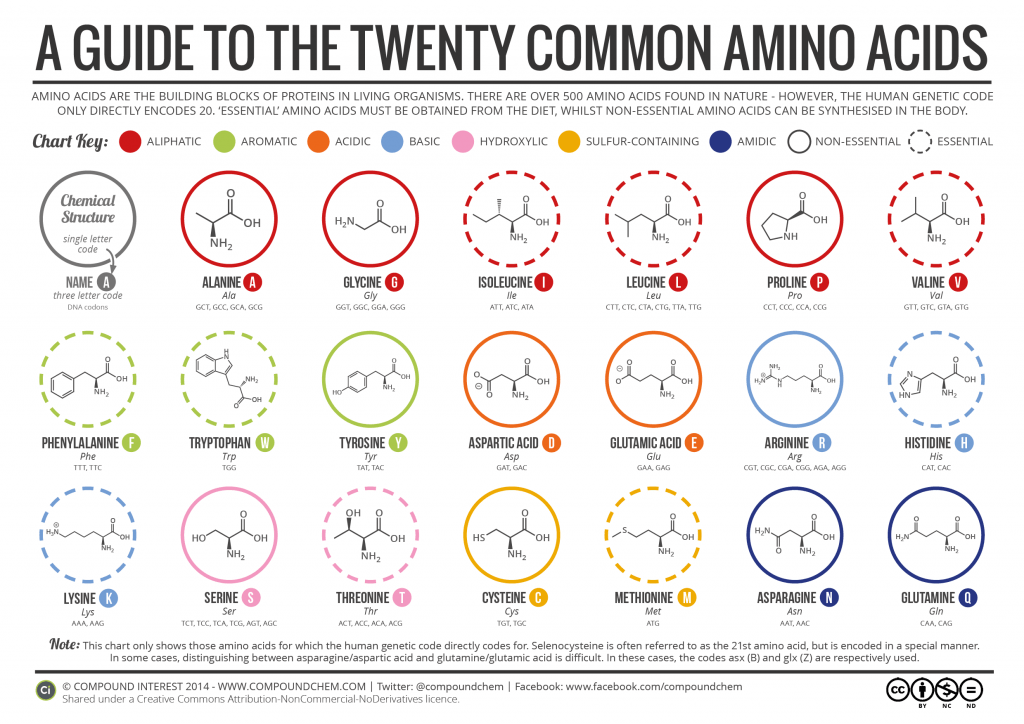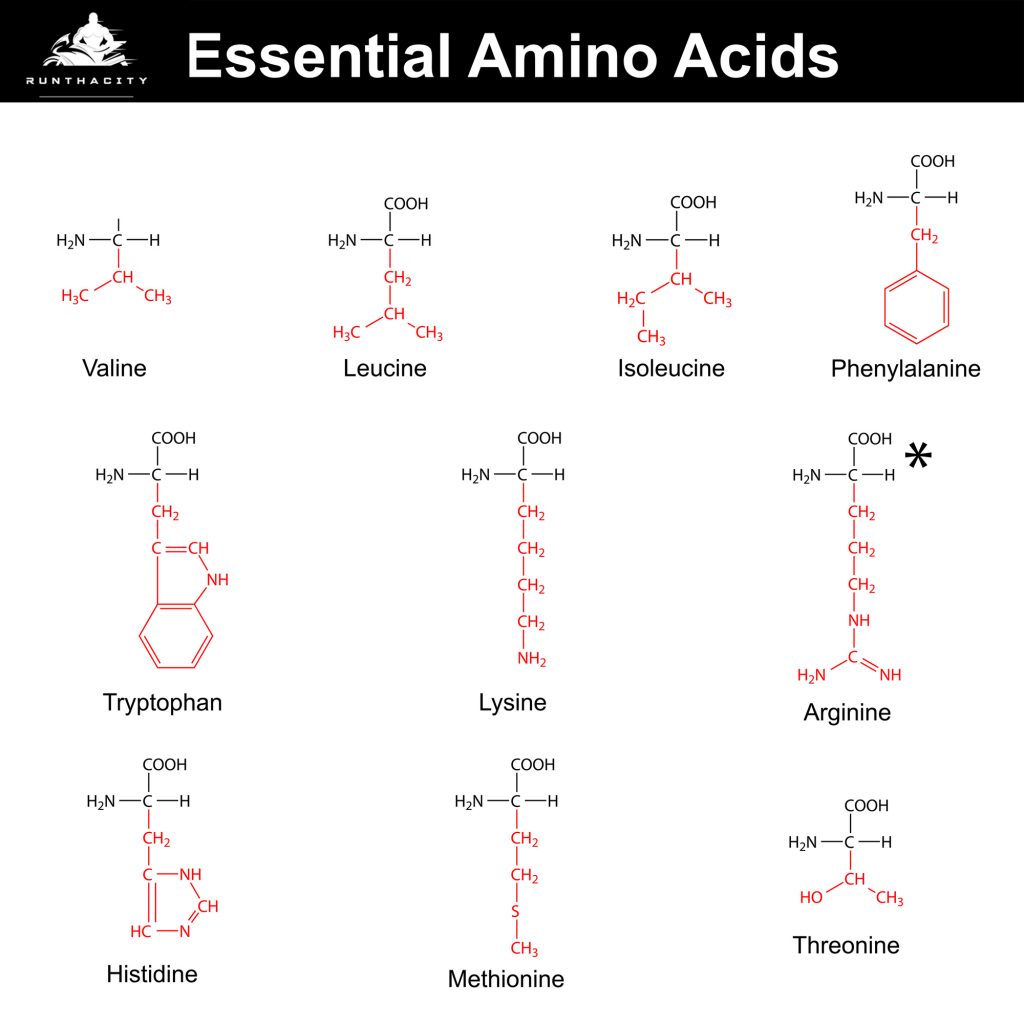What Are Amino Acids?
Amino Acids
Amino acids play a vital role in the numerous functions of the body; they are the building block of protein. Twenty amino acids are needed by the body to build various proteins used in the repair, growth, and maintenance of body tissues. Some of these amino acids can be manufactured by the body itself and are called non-essential amino acids, while others must come from the diet and are called essential amino acids.
These classification of the amino acid whether essential or non-essential does not reflect its importance because all of the twenty amino acids are very important for health, instead this classification system is just a reflection of whether the body is capable or not of producing a particular amino acid.
All these amino acids keep us vibrant, alive, and healthy. Any deficiency in a single amino acid will cause health problems for us; a single deficiency should be replaced to fulfill its functions.

Essential Amino Acids
Known as building blocks of protein, there are about 20 of them but only 9 are considered as essential amino acids. They cannot be produced by the body alone so human beings can only obtain them from foods or supplements.

Use To Bodybuilders: Minimal, only in improving digestion Dosage: Minimum of 1000 mg daily, but the recommendation is 8-10 mg a day per kilogram of bodyweight. Chances are you get at least two or three times that in your diet. Overdosing: Too much histidine may lead to stress and the aggravation of mental disorders such as anxiety and schizophrenia. Medical Uses: Used in the treating of arthritis and nerve deafness. Sources: Found in dairy, meat, poultry, fish as well as rice, wheat and rye. Deficiency:Unknown.

Use To Bodybuilders: Of similar importance as leucine, Very important as part of the BCAA stack. Dosage: 10-12 mg per kilo of bodyweight. Overdosing: Causes elevated urination. No serious problems. May become serious if you have kidney or liver disease. Medical Uses: Wound healing. Sources: Chicken, cashews, fish, almonds, eggs, lentils, liver, meat. Deficiency: Unknown.

Use To Bodybuilders: Leucine may be one of the strongest natural anabolic agents in the world. It will not give you amazing results, however, simply because you are already taking in quite large amounts of it. Dosage: 16 mg per kilo of bodyweight. Overdosing:Unknown, may increase ammonia. Medical Uses: Prevention of muscle-wasting in states of deprivation. Sources: Found in nearly all protein sources, including brown rice, beans, nuts, and whole wheat. Deficiency: Unknown.

Use To Bodybuilders: Next to the maintenance and manufacture of muscle protein, Lysine plays a role in revitalizing the body to combat fatigue and overtraining and it maintains a positive nitrogen balance, creating an anabolic environment within the body. Dosage: Normal recommendation is 12 mg per kilo of bodyweight, but daily intake exceeds that, and even when taking in 1.5 grams of protein per pound of bodyweight, a couple of extra mg won’t hurt. It’s a priority amino acid to the athlete. but beware of overdosing. Overdosing: Could result in higher LDL cholesterol, diarrhea and gallstones. Medical Uses:Treating of cold sores and lack of energy. Sources: Cheese, eggs, milk, meat, yeast, potatoes and lima beans. Deficiency: May lead to enzyme disorders, lack of energy, hair loss (common for protein shortage), weight loss, no appetite and loss of concentration.

Use To Bodybuilders: Fat metabolization, better digestion and anti-oxidizing properties make this a valuable compound. Dosage: 12 mg per kilo of bodyweight. If you think it may be a good idea to supplement this, you may as well invest in some ZMA. The supplement is cost-effective and yields higher results than just Methionine. Overdosing:None, except in case of a shortage of B-Vitamins, in which case you are an easy target for arteriosclerosis. Medical Uses: Used to treat depression, arthritis and liver disease. Sources: Meat, fish, beans, eggs, garlic, lentils, onions, yogurt and seeds. Deficiency:Causes dementia, fatty liver, slow growth, weakness, skin lesions and edema.

Use To Bodybuilders: Apart from motivation and extra Vitamin D, Phenylalanine is of the use because of the nerve upgrading which will allow for maximal contraction and relaxation of the muscles. The DL-form is often supplemented as an endurance enhancer. Because of the toxicity level, this is never done long-term. Dosage:Recommendation is 14 mg per kilo of bodyweight. You’ll be getting more than that no doubt, and I see no need to increase that. Especially with the potential side-effects. Overdosing: This is not a wise supplement to be taking by pregnant women and diabetics. It results in higher blood pressure, headaches, nausea, heart trouble and nerve damage. Medical Uses: For treatment of arthritis and depression. Sources: All dairy products, almonds, avocados, nuts, and seeds. Deficiency: Its rare, but if it occurs it leads to weakness, lethargy, liver damage and stunted growth.

Use To Bodybuilders: Absorption of protein, maintenance of muscle and important to good health. Dosage: 8 mg per kilo of bodyweight, generally advised in amounts of 100-500 mg when supplemented. Overdosing: Not known. Medical Uses: Treatment for mental health. Sources: Meat, dairy, and eggs. Deficiency: Irritability and being difficult, nothing severe. Less immunity against disease.


Use To Bodybuilders: In combination with Isoleucine and Leucine. Dosage: 16 mg per kilo of bodyweight. Overdosing: Crawling sensation in the skin is common, hallucination, may be hazardous to people with kidney and liver disease. Medical Uses: None, not separately. Sources: Dairy, meat, grain, mushrooms, soy, peanuts. Deficiency: Leads to MSUD.

Conditionally Essential Amino Acids

Use To Bodybuilders: Too many to name. If you read the above, I’m sure you’ll realize that. Dosage: No recommended dosage. I’m not even sure if anyone produces free-form arginine, but if you have two equal products and one contains more arginine, the choice should be simple. To supplement in large doses may lead to side effects, but getting protein powders and weight-gainers enriched with extra arginine makes sense. Overdosing: Skin thickening and coarsening, weakness, diarrhea, nausea and loss of immunity to viruses. So it is not a smart idea for people with viral diseases. Medical Uses:Treatment of sexual impairment, and often prescribed against high levels of cholesterol. Sources: Whole-wheat, nuts and seeds, rice, chocolate, raisins, soy. Deficiency: Impaired insulin production, hair loss. But hardly ever occurs in healthy people. Precaution: Do not stack arginine with lysine because they compete for absorption.

Use To Bodybuilders: Metabolizer of B-vitamins, detoxification of damage due to other supplements, and potentiating insulin. Dosage: 200-300 mg, two to three times daily. Overdosing: Only possible in diabetics. Medical Uses: Liver-protecting and easing of debilitating diseases. Sources: Poultry, wheat, broccoli, eggs, garlic, onion, and peppers. Deficiency: Unknown.
Glutamine is a non-essential amino acid that is produced naturally by the body. Sixty percent of glutamine is found in the skeletal muscles.
The remainder is in the lung, liver, brain, and stomach tissues.
Over 60% of our amino acids come in the form of glutamine. Under normal conditions, our body can produce more than enough.
However, during times of stress, glutamine reserves are depleted and must be replenished through supplementation. This includes stress that the body is under during periods of exercise.
If you have too little glutamine in your system, it can result in muscle loss.
This amino acid is essential to muscle building because it helps nitrogen in the body move around to where it needs to be. You have to have a positive nitrogen balance in order to gain muscle mass.
Use To Bodybuilders: The preservation of muscle mass and the supplying of an alternate energy source in glucose deprivated conditions (diets and such). Dosage: Don’t go overboard. 5-10 grams can illicit an effect, but bodybuilders on low-carb diets for shows could go as high as 30-35. Overdosing: Only dangerous in people with liver or kidney trouble. Medical Uses: Sources: Large amounts in all high-protein foods. Deficiency :Unknown, glutamine is the most manufactured protein in the body.




Non Essential Amino Acids





Taurine aids in the clearing of free radical wastes and helps in the stabilization of the excitability membranes which is very vital in the control of epileptic seizures. Taurine is one of the factors that are needed for the control of many biochemical changes during the aging process.
Frequently Asked Questions
Amino acids are the building blocks of proteins. There are 20 standard amino acids out of which almost all proteins are made.
There are 20 amino acids in your body’s proteins, nine are essential to your diet because your cells cannot manufacture them: histidine, isoleucine, leucine, lysine, methionine, phenylalanine, threonine, tryptophan and valine. A tenth amino acid, arginine, is essential during times of rapid growth – for example, during childhood – because, although you can synthesize it, you can’t always produce enough of it.
There are 2 times you can take amino acids for optimal results.
- 30 to 60 minutes before your workout
- After your workout to aid with recovery.
Branched Chain Amino Acids (BCAAs) refers to three amino acids: leucine, isoleucine, and valine.
For people with low dietary protein intake, BCAA supplementation can promote muscle protein synthesis and increase muscle growth over time. Supplementation can also be used to prevent fatigue in novice athletes.
Nonessential amino acids are amino acids made by the body from essential amino acids or normal breakdown of proteins. [1] Of the 20 standard amino acids, 12 are nonessential. [2] These are: alanine, asparagine, aspartate, cysteine, glutamate, glutamine, glycine, proline, serine, tyrosine, arginine, and histidine. The amino acids cysteine, tyrosine, histidine and arginine are considered semiessential amino acids in children, because the metabolic pathways that synthesize these amino acids are not fully developed yet.
Amino acids are nitrogen-containing molecules that are the building blocks of all proteins in food and in the body. They can be used as energy, yielding about 4 calories per gram, but their primary purpose is the synthesis and maintenance of body proteins including, but not limited to, muscle mass.
Amino acid supplements slowly weaken with age. Quality amino acid supplements will maintain potency approximately 1 to 2 years following expiration.
- BCAAs (branched-chain amino acids L-leucine, L-isoleucine and L-valine), which are valuable building blocks for muscle tissue growth and repair,
- L-arginine, which improves blood flow (“Pump”),
- L-carnitine, which enhances fat burning and accelerates recovery,
- L-glutamine, which increases water retention in muscle cells and helps signalling cell growth.
The branched-chain amino acids leucine, isoleucine and valine are widely marketed for weight loss. The link stems from limited research published in the 1990s, which suggested that combining BCAAs with a restricted-calorie diet promotes weight loss. One such study, published in the January 1997 issue of the International Journal of Sports Medicine, found that BCAAs caused significant weight loss in elite wrestlers when combined with calorie restriction. Recently published research confirming the findings of earlier studies is lacking, making it impossible to know for sure whether supplementing BCAAs alone is effective for weight loss.
Amino acids are grouped according to what their side chains are like. The nine amino acids that have hydrophobic side chains are
- glycine (Gly),
- alanine (Ala),
- valine (Val),
- leucine (Leu),
- isoleucine (Ile),
- proline (Pro),
- phenylalanine (Phe),
- methionine (Met), and
- tryptophan (Trp)
Proteins, our most complex substances, are made up of varying combinations of nitrogen-containing amino acids.1 There are twenty different amino acids that are important to the body. These twenty combine together in hundreds of intricate chemical patterns to create a variety of complex protein structures.
Plants contain many proteins which are formed from amino-acids. This is why vegetarians can get protein in their diet despite not eating meat: the vegetable/ fruit contains proteins made up from amino-acids.
- Tempeh
- Lentils
- Black Beans
- Quinoa
- Soy Milk
- Pistachios
- Pumpkin Seeds
Yes, Fruits consist of living cells, and all living cells contain protein, which are made of amino acids.
Semi-essential amino acids are those that can be synthesized by the body’s metabolic pathways, but possibly not in sufficient quantity (especially in children or the ill), and therefore may have to be supplied at least in part by the diet. Examples in humans are histidine and arginine. The term is also sometimes applied to amino acids that are produced from essential amino acids and may be required in the diet if there is not a sufficient amount of the precursor.
About Me
A man with two hobbies. I’ve always had a passion for sportbikes and over the years became a gym rat. Join me through my journey of Fitness Vlogging, Motovlogging, and being a Self-proclaimed Iron Addict. Riding a 2004 Yamaha YZF-R6. Subscribe Like, Follow & Share because you can!
No products found.
Popular Guides
Recent Posts
- Shoulder Day with Almeen Swint, RunThaCity, and Mack: No Excuses, Just Volume
- The 80-Pound Solution: Revolutionizing Chest Training with Simplified Volume
- Muscle Fiber Saturation: The Hidden Benefits of 200-Rep Dumbbell Press Workouts
- From the Ground Up: Why Leg Day Is the Foundation of Strength
- Hybrid Athletes: The Ultimate Guide to Versatile Fitness
No products found.
Yamaha R6 Specs
No products found.







